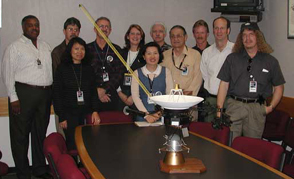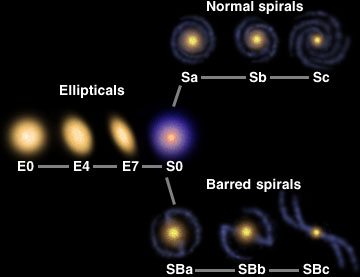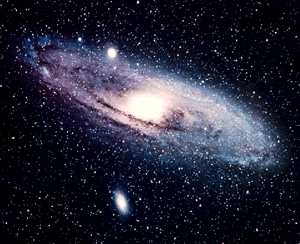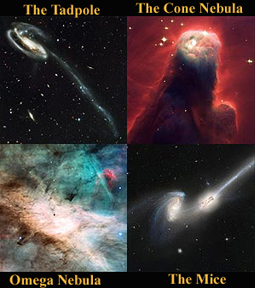A composite image of the first four images taken by Hubble Space Telescope's new Advanced Camera for Surveys (ACS).
Click on image for full size
Windows Original (Based on Image courtesy of NASA and the ACS Science Team
Hubble's New Look
News story originally written on May 1, 2002
The pictures released by
Hubble Space Telescope's new Advanced Camera for Surveys (ACS) are nothing but FAR OUT! This new camera was installed on Hubble during a
servicing mission in March 2002. As can be seen by these spectacular images, the camera is working wonderfully!
Four ACS images of the universe were released yesterday. The first is a colliding galaxy fondly named the Tadpole. Tadpole is 420 million light-years away. The "tail" that you see is actually a line of stars!
Another image shows the collision of two spiral galaxies. These two galaxies are known as the Mice. A third image shows the cold dust and gas of the Cone Nebula. Finally, you can see the Omega Nebula, which is a hotbed for new star and planet formation.
"Today marks the beginning of a new era of exploration with
Hubble," said Dr. Ed Weiler, Associate Administrator for
Space Science at NASA Headquarters, Washington. "Our team of
scientists and engineers on the ground and the astronauts in
space once again did the impossible. After 12 years in space,
Hubble not only was given a major overhaul, its new camera
has already shown us that, even after 12 years of great
science and astounding images, we haven't seen anything yet."
You might also be interested in:

The Hubble Space Telescope (HST) was one of the most important exploration tools of the past two decades, and will continue to serve as a great resource well into the new millennium. The HST is credited
...more
The servicing mission to the Hubble Space Telescope in early March looks to have been a great success. Four weeks after the servicing mission, the Telescope has been declared healthy and fit...and is frankly,
...more
The introduction of telescopes to the study of astronomy opened up the universe, but it took some time for astronomers to realize how vast the universe could be. Telescopes revealed that our night sky
...more
Spiral galaxies may remind you of pinwheels turning slowly as though in some intergalactic breeze. They are rotating disks of gas, dust and stars. Through a telescope or binoculars, the bright nucleus
...more
It was another exciting and frustrating year for the space science program. It seemed that every step forward led to one backwards. Either way, NASA led the way to a great century of discovery. Unfortunately,
...more
The Space Shuttle Discovery lifted off from Kennedy Space Center at 2:19 p.m. EST, October 29th. The sky was clear and the weather was great as Discovery took 8 1/2 minutes to reach orbit for the Unitied
...more
A moon was discovered orbiting the asteroid, Eugenia. This is only the second time in history that a satellite has been seen circling an asteroid. A special mirror allowed scientists to find the moon
...more















